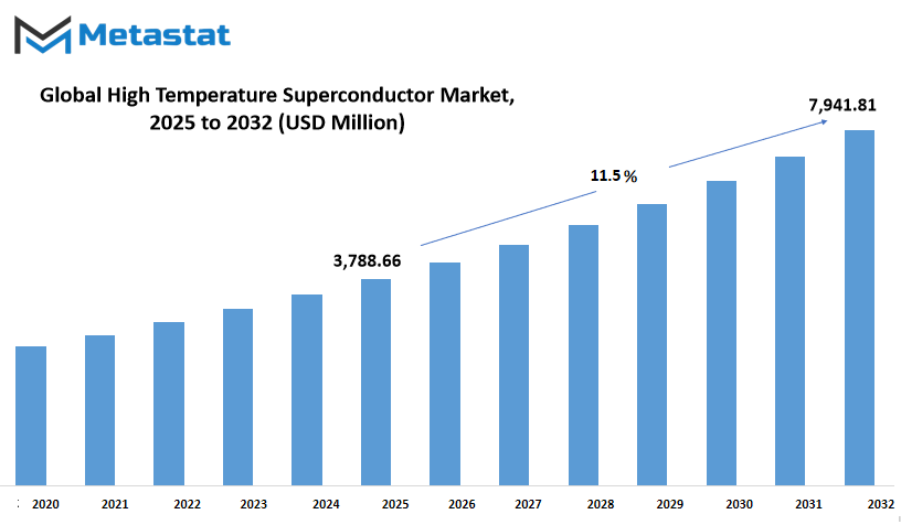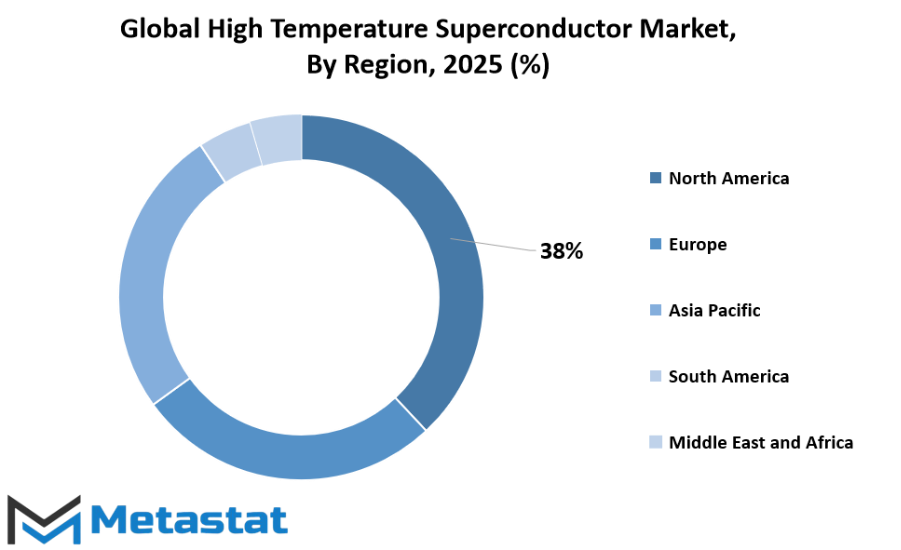MARKET OVERVIEW
The global high temperature superconductor market will remain in the spotlight as next-generation materials redefine future technology. Although scientists have researched superconductivity for many years, industries will learn to better appreciate the useful applications of high temperature superconductors in changing the way electricity is delivered, stored, and used across a range of industries. As opposed to traditional conductors, these substances will conduct electricity with no resistance at comparatively elevated temperatures, paving the way for more power-efficient and compact designs for power grids, transport, and medicine. Over the next few years, the world market for high temperature superconductors will not be limited to research laboratories or small research projects.
Electric power generators and distributors will be trying superconducting wires that have the capability to carry much more current than copper wires with the same thickness. This shift will ultimately result in more compact, lighter, and stronger power systems that are able to meet the needs of high-density urban regions. Meanwhile, diagnostic imaging systems will rely on superconducting magnets in the hospitals, where improved resolution and lower cost of operation will serve to benefit medical practice. Transportation will be another phase where the global high temperature superconductor market will demonstrate its relevance. Magnetic levitation trains, for instance, will need superconducting materials to enable frictionless high-speed transportation. Countries investing in infrastructure will turn to such systems to minimize travel time with a reduction in carbon footprints. Superconductors will be utilized in electric aircraft projects as well, as light-weighting and efficient improvement will continue to be key drivers for the aviation industry's transformation. The technology that deals with these materials will encounter scientific as well as commercial challenges.
Scientists will be challenged to create compounds that continue to exhibit superconductivity at temperatures closer to that of ambient conditions, as even high temperature superconductors continue to need cooling that adds cost and complexity.
Producers will have to come up with processes that can be scaled up to make wires and tapes that can withstand mechanical stress without losing their superconducting state. These challenges will retard explosive adoption, but the impetus to overcome them will dictate the course of the world high temperature superconductor market. The most fascinating element of this market will be its influence upon digital technology. Superconducting circuits will ultimately process data at a speed that cannot be matched by traditional silicon-based technology. Future data centers will require quicker and more efficient systems, and superconductors will provide a viable solution once manufacturing issues are resolved.
As quantum computing and artificial intelligence continue their advance, demand for superconducting components will increase, tying the development of computing to growth in the market. The global high temperature superconductor market will ultimately be about the commercialization of a scientific achievement. It will define the way that societies tackle energy, health, mobility, and technology over the coming decades. Although short-term advancement can seem incremental, the long-term landscape will accentuate the contribution of these materials to constructing cleaner cities, more intelligent power systems, and quicker machines. The industry's narrative will be one of patience, perseverance, and exploration, with the promise of a future in which superconductivity is a normal part of life.
Global high temperature superconductor market is estimated to reach $7,941.81 Million by 2032; growing at a CAGR of 11.5% from 2025 to 2032.

GROWTH FACTORS
The global high temperature superconductor market is entering a stage where demand is being shaped by several important factors that will define its future direction. One of the strongest forces driving this market is the rising need for energy-efficient power transmission and storage solutions. As worldwide electricity consumption continues to grow, the pressure on existing infrastructure is becoming more evident. High temperature superconductors, with the ability to carry large currents with almost no energy loss, offer a solution that will help reduce wastage, improve reliability, and strengthen grid performance. This makes them highly attractive for nations and industries looking to reduce operational costs while also cutting carbon emissions.
Another critical area fueling the growth of the global high temperature superconductor market is the increasing use in medical imaging and scientific research. Magnetic Resonance Imaging technology, which relies on superconducting magnets, is becoming more advanced and widely adopted in healthcare. High temperature superconductors allow these machines to operate more efficiently, potentially reducing the cost of procedures and improving patient care. Beyond healthcare, scientific institutions are turning to these materials for particle accelerators, fusion energy research, and advanced laboratory experiments. These projects demand high levels of precision and efficiency, making superconductors essential for innovation in multiple scientific fields.
Despite these advantages, the global high temperature superconductor market faces significant challenges. The high cost of production and maintenance of HTS materials continues to be a major barrier. Manufacturing requires specialized conditions and careful handling, which not only increases expenses but also slows down commercial deployment. In addition, the fragility of superconducting materials and the complex fabrication processes limit their large-scale adoption. Without breakthroughs in cost reduction and material durability, expansion into mainstream applications will remain difficult.
Still, opportunities are on the horizon. The integration of renewable energy into existing power systems will create strong demand for technologies that can handle fluctuations and store energy more efficiently. Superconductors have the potential to make renewable sources such as wind and solar more reliable by stabilizing grids and supporting energy storage systems. The development of smart grids, designed to optimize power use and distribution, also points toward a future where superconductors play a central role. With continued research, investment, and collaboration across industries, the global high temperature superconductor market will likely unlock new possibilities that reshape energy, healthcare, and scientific progress in the coming years.
MARKET SEGMENTATION
By Type
The global high temperature superconductor market is expected to witness strong growth as industries move toward advanced technologies that demand greater efficiency and energy savings. High temperature superconductors are materials that can conduct electricity without resistance at higher temperatures compared to traditional superconductors. This ability reduces energy loss, making them highly valuable in different sectors. Continuous research and innovation will drive their use across power grids, medical devices, transportation, and industrial equipment. As the demand for clean and reliable energy solutions grows, this market will play an important role in shaping the future of energy systems worldwide.
The global high temperature superconductor market by type is further segmented into 1G HTS and 2G HTS. First-generation HTS wires have already been widely applied in various projects, particularly in large-scale transmission and scientific research applications. These have served as the foundation for exploring superconducting solutions. Second-generation HTS, often seen as the next step forward, is designed with better efficiency, improved durability, and lower costs over time. With industries demanding systems that handle heavier loads while reducing maintenance, 2G HTS is expected to dominate future growth. Both generations will continue to have a place in the market, but the gradual shift toward 2G will highlight the focus on scalability and long-term performance.
Applications of high temperature superconductors go beyond simple transmission of power. In power generation and distribution, they offer the possibility of constructing grids that handle increasing energy demands while keeping losses at a minimum. In transportation, superconductors could support high-speed trains and advanced propulsion systems that require powerful magnetic fields. Medical technology will also benefit, with devices such as MRI machines becoming more effective and less costly to operate. These wide-ranging applications demonstrate how the global high temperature superconductor market will shape industries that depend on strong, efficient, and reliable energy systems.
Future developments will likely focus on making superconducting technology more affordable and widely available. Manufacturing methods are improving, which will lower costs and increase adoption. Governments and private companies are investing in projects that highlight how superconductors can solve modern energy challenges. With climate goals pushing industries to cut emissions and conserve resources, superconductors provide a practical path forward. The combination of research, policy support, and market demand ensures steady expansion in the coming years.
In conclusion, the global high temperature superconductor market will remain central to technological advancement and energy efficiency. With the growth of both 1G HTS and 2G HTS, along with expanding applications in critical industries, this market will continue to transform the way energy is transmitted, stored, and utilized.
By Form
The global high temperature superconductor market is moving toward a future where advanced materials will transform multiple industries. Growing attention is being directed at improving energy efficiency, lowering transmission losses, and supporting next-generation applications that require high performance. The development of these superconductors will reshape energy networks, transportation systems, medical equipment, and electronic devices, creating opportunities that will expand across both established and emerging markets.
The global high temperature superconductor market is divided into wire and cable, coatings, thin films, bulk materials, and powders. Each category will play a unique role in building technologies of the future. Wire and cable will be critical for power transmission and distribution, enabling grids that carry more electricity with far less waste. Coatings will strengthen durability and efficiency, making superconducting systems more practical for long-term use. Thin films will find value in electronics and sensors, helping industries achieve better precision in performance. Bulk materials will provide the foundation for large-scale projects such as magnets used in energy storage or research facilities. Powders will allow manufacturers to design new composites and products that expand the use of superconductors in specialized areas.
The global high temperature superconductor market will benefit from increased investment in clean energy and the growing demand for efficient electrical systems. Governments and private companies are focusing on reducing carbon emissions, and superconductors will support this shift by making grids more sustainable. As industries aim for innovation, superconductors will become an essential part of advanced infrastructure, enabling systems that are not only more efficient but also more reliable under heavy loads.
Future growth will also be driven by healthcare technology, where superconductors are used in imaging systems such as MRI machines. Improvements in this field will allow faster diagnosis and better patient care. In transportation, superconductors will support new designs for high-speed systems that reduce travel time while lowering energy consumption. Research institutions will continue to explore new applications, and this constant innovation will keep the global high temperature superconductor market dynamic and expanding.
With advances in manufacturing and ongoing research, costs are expected to decrease, which will open access for a wider range of industries. The coming years will see a shift from limited experimental use to widespread adoption. Each form—wire and cable, coatings, thin films, bulk materials, and powders—will contribute to shaping the future of technology. The global high temperature superconductor market will therefore stand as a key driver of industrial progress, powering solutions that are efficient, sustainable, and forward-looking.
By Application
The global high temperature superconductor market will continue to grow as demand for advanced technologies expands across different sectors. The material is valued for its ability to conduct electricity without resistance at higher temperatures compared to traditional superconductors, and this feature makes it vital for innovation. By application, the market is divided into Magnetic Resonance Imaging (MRI), Power Generation and Transmission, Transport such as Maglev Trains, Particle Accelerators, Quantum Computing, and Scientific Research. Each of these areas highlights how the market will shape the future of industries that rely heavily on efficiency, precision, and energy savings.
In medical imaging, MRI technology will continue to depend on high temperature superconductors to deliver clearer scans with reduced energy use. This improvement will not only enhance diagnostic accuracy but also make the machines more affordable and widely accessible. In power generation and transmission, the technology will play a role in reducing energy loss across grids. Growing energy demand and the shift toward renewable sources will push utilities to adopt superconducting cables and systems that can carry more power with less waste.
Transport applications such as Maglev trains will benefit from faster, quieter, and more sustainable travel. High temperature superconductors will allow trains to float on magnetic fields, reducing friction and opening the path for ultra-high-speed transport networks in the future. For particle accelerators, the market will continue to support advanced scientific experiments. Superconducting magnets made with this technology will help researchers unlock new discoveries in physics and material science, creating tools for both academic and industrial research.
Quantum computing is another major driver for the global high temperature superconductor market. The material will be used to build stable qubits, which are essential for computers capable of solving problems beyond the reach of conventional systems. As businesses and governments seek solutions for complex challenges, investment in superconducting quantum technology will continue to rise. Scientific research more broadly will also benefit, as superconductors open new possibilities for experimentation in fields that require extreme precision and control.
The future of the global high temperature superconductor market will be shaped by the growing need for efficiency, sustainability, and technological advancement. As applications expand, industries will adopt superconducting solutions to cut costs, improve performance, and enable new capabilities. From healthcare to transportation and computing, this market will stand at the center of progress, creating opportunities that will redefine how energy and technology are used worldwide.
By End-Use Industry
The global high temperature superconductor market is moving toward a future where advanced technology will play a key role in shaping several industries. High temperature superconductors have already shown their ability to carry electricity without resistance, and this ability will expand opportunities across multiple fields. As new applications continue to emerge, the demand for these superconductors will not remain limited to laboratories or specialized projects but will steadily spread into daily operations of industries that rely on efficiency and innovation.
In healthcare, the global high temperature superconductor market will create solutions that transform diagnostic imaging and medical treatment. Devices such as MRI machines will become more compact and energy efficient, making them easier to install even in facilities with limited resources. Improved performance will also allow for faster and more precise imaging, which will help in early detection of complex conditions. With healthcare systems around the world seeking both cost reduction and better patient outcomes, superconductors will play a significant role in driving progress.
Energy and power will remain one of the strongest areas of growth for the global high temperature superconductor market. As electricity demand continues to rise, efficient energy transmission will be a priority. Superconducting cables will allow for lower energy loss over long distances, supporting the growth of renewable power sources and ensuring stable distribution across regions. The ability to store and transfer large amounts of electricity will help balance fluctuations from solar and wind energy, which are often dependent on weather conditions.
The transportation sector will also see a noticeable impact from the global high temperature superconductor market. Superconducting materials will support the development of faster and more efficient trains, including magnetic levitation systems that reduce friction and energy consumption. Beyond rail, other transportation systems may integrate superconductors to improve speed, safety, and energy use. These changes will shape how goods and people move in the future.
In aerospace, the global high temperature superconductor market will strengthen design possibilities for aircraft and spacecraft. Lighter systems, higher energy efficiency, and stronger magnetic technologies will all be made possible by superconductors. Telecommunications will benefit as well, with superconductors enabling faster signal transmission, stronger connectivity, and reduced energy usage in networks that must handle growing data demand.
Finally, manufacturing industries will rely on superconductors for advanced machinery that requires high precision and reduced energy costs. By lowering operational barriers, the global high temperature superconductor market will support industries in building products more efficiently and with greater sustainability. As the future unfolds, this market will continue to stand at the center of technological progress, offering industries the tools needed to advance in ways once thought impossible.
|
Forecast Period |
2025-2032 |
|
Market Size in 2025 |
$3,788.66 million |
|
Market Size by 2032 |
$7,941.81 Million |
|
Growth Rate from 2025 to 2032 |
11.5% |
|
Base Year |
2024 |
|
Regions Covered |
North America, Europe, Asia-Pacific Green, South America, Middle East & Africa |
REGIONAL ANALYSIS
The global high temperature superconductor market is expected to play a central role in shaping the future of multiple industries as technological needs continue to grow. High temperature superconductors are being explored for their ability to conduct electricity with minimal resistance, which makes them attractive for power grids, advanced medical equipment, and high-speed computing systems. With ongoing research and rising investments, the market will likely expand at a steady pace, driving innovation and adoption across regions.
Based on geography, the global high temperature superconductor market is divided into North America, Europe, Asia-Pacific, South America, and Middle East & Africa. North America is further divided into the U.S., Canada, and Mexico, with strong demand expected due to established infrastructure and active research institutions. Europe, consisting of the UK, Germany, France, Italy, and the Rest of Europe, is focusing on sustainable energy projects and transportation improvements, which will likely push adoption of advanced superconducting technologies.
Asia-Pacific, segmented into India, China, Japan, South Korea, and the Rest of Asia-Pacific, is projected to be one of the fastest growing regions in this field. Nations in this area are prioritizing investments in clean energy, urban development, and digital transformation. As a result, superconductors are expected to support the need for efficient energy distribution and advanced industrial applications. In South America, with Brazil, Argentina, and the Rest of South America, opportunities will emerge gradually as investments in power infrastructure and healthcare systems rise. The Middle East & Africa, categorized into GCC Countries, Egypt, South Africa, and the Rest of Middle East & Africa, will likely concentrate on integrating superconductors into energy projects, especially as these nations continue to diversify economies and prepare for long-term sustainability.
The future of the global high temperature superconductor market will be shaped by increasing pressure to find energy-efficient solutions. Demand for stronger and more reliable power grids is expected to push governments and industries to adopt superconducting technologies. Healthcare will also see wider applications, as advanced imaging systems and diagnostic tools benefit from superconductors. With continued innovation, even transportation systems such as high-speed trains could be transformed, providing faster and more efficient movement of people and goods.
As regions continue to invest in research and infrastructure, the global high temperature superconductor market will likely emerge as a foundation for future technological progress. From efficient energy use to breakthroughs in healthcare and digital transformation, superconductors are set to become essential in meeting global demands.

COMPETITIVE PLAYERS
The global high temperature superconductor market is expected to bring major changes to industries worldwide as demand for faster, more efficient, and more sustainable technologies continues to rise. High temperature superconductors, often valued for their ability to carry electricity without resistance at relatively higher temperatures compared to traditional superconductors, are now being looked at as a critical solution for future power systems, medical devices, and advanced transportation networks. As the need for clean energy grows, this technology will play an important role in reducing energy loss and improving overall efficiency across different applications.
One of the strongest factors driving the global high temperature superconductor market will be the increasing pressure to adopt renewable energy and smart grid technologies. Power transmission and distribution networks waste significant amounts of energy due to resistance in conventional wires, but superconducting materials can address this challenge by delivering power more effectively. This advantage will be vital as countries push to expand renewable energy use and integrate large amounts of wind, solar, and hydropower into the grid. Superconductors also allow for compact and lighter equipment, which will lower the overall costs of upgrading infrastructure in the future.
The global high temperature superconductor market is shaped by a number of leading companies that continue to develop new products and improve manufacturing methods. Key players include American Superconductor (AMSC), SuperPower Inc. (Furukawa Electric Co., Ltd.), High Temperature Superconductors, Inc., Theva Dünnschichttechnik GmbH, Fujikura Europe Limited, Sumitomo Electric Industries, Ltd., and Shanghai Shangchuang Superconducting Technology Co., Ltd. Each of these organizations is investing heavily in research and development to increase the stability, flexibility, and scalability of superconducting wires and systems. Their contributions will decide how quickly and broadly the technology becomes part of daily life.
Another promising area for the global high temperature superconductor market will be healthcare. Magnetic resonance imaging (MRI) machines rely on superconductors to produce strong magnetic fields. With improvements in high temperature materials, the machines will become more efficient, more affordable, and more widely accessible. Beyond healthcare, industries such as defense, aerospace, and high-speed transportation are expected to see major benefits, with superconductors enabling stronger magnets for particle accelerators, advanced propulsion systems, and maglev trains.
Looking forward, the global high temperature superconductor market will not only reshape how energy is transmitted but also redefine possibilities across industries. With rising investment, collaboration among international firms, and increasing demand for cleaner and faster technologies, superconductors are set to become a cornerstone of innovation. The companies leading this progress will influence not only market growth but also the pace at which society adopts more advanced and sustainable technologies.
High Temperature Superconductor Market Key Segments:
By Type
- 1G HTS
- 2G HTS
By Form
- Wire and Cable
- Coatings
- Thin Films
- Bulk Materials
- Powders
By Application
- Magnetic Resonance Imaging (MRI)
- Power Generation and Transmission
- Transport (Maglev Trains)
- Particle Accelerators
- Quantum Computing
- Scientific Research
By End-Use Industry
- Healthcare
- Energy & Power
- Transportation
- Aerospace
- Telecommunications
- Manufacturing
Key Global High Temperature Superconductor Industry Players
- American Superconductor (AMSC)
- SuperPower Inc. (Furukawa Electric. Co., Ltd.)
- High Temperature Superconductors, Inc.
- Theva Dünnschichttechnik GmbH
- Fujikura Europe Limited
- Sumitomo Electric Industries, Ltd.
- Shanghai Shangchuang Superconducting Technology Co., Ltd.
WHAT REPORT PROVIDES
- Full in-depth analysis of the parent Industry
- Important changes in market and its dynamics
- Segmentation details of the market
- Former, on-going, and projected market analysis in terms of volume and value
- Assessment of niche industry developments
- Market share analysis
- Key strategies of major players
- Emerging segments and regional growth potential








 US: +1 3023308252
US: +1 3023308252






